Page 341 of 468
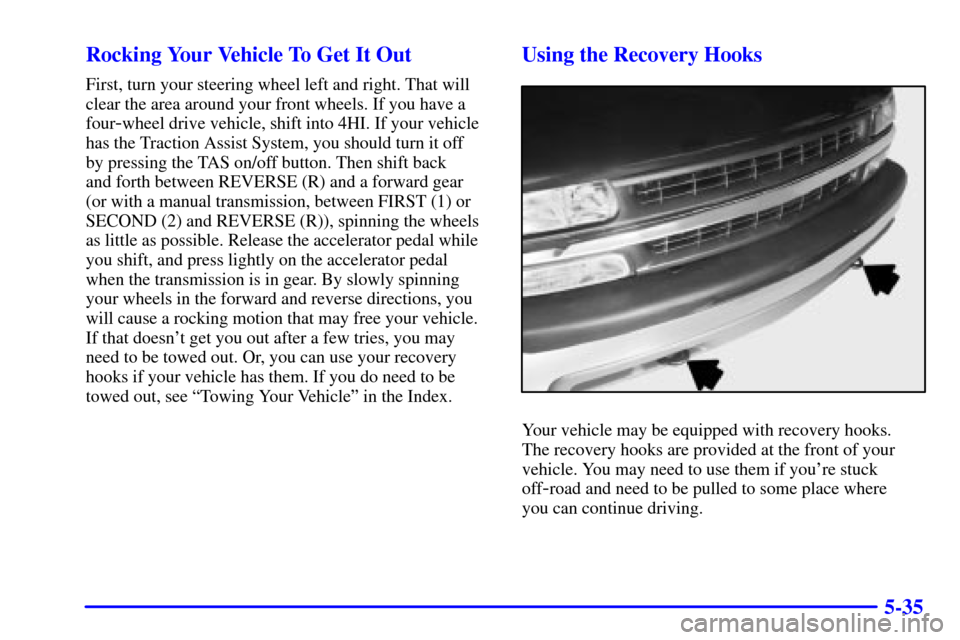
5-35 Rocking Your Vehicle To Get It Out
First, turn your steering wheel left and right. That will
clear the area around your front wheels. If you have a
four
-wheel drive vehicle, shift into 4HI. If your vehicle
has the Traction Assist System, you should turn it off
by pressing the TAS on/off button. Then shift back
and forth between REVERSE (R) and a forward gear
(or with a manual transmission, between FIRST (1) or
SECOND (2) and REVERSE (R)), spinning the wheels
as little as possible. Release the accelerator pedal while
you shift, and press lightly on the accelerator pedal
when the transmission is in gear. By slowly spinning
your wheels in the forward and reverse directions, you
will cause a rocking motion that may free your vehicle.
If that doesn't get you out after a few tries, you may
need to be towed out. Or, you can use your recovery
hooks if your vehicle has them. If you do need to be
towed out, see ªTowing Your Vehicleº in the Index.
Using the Recovery Hooks
Your vehicle may be equipped with recovery hooks.
The recovery hooks are provided at the front of your
vehicle. You may need to use them if you're stuck
off
-road and need to be pulled to some place where
you can continue driving.
Page 344 of 468
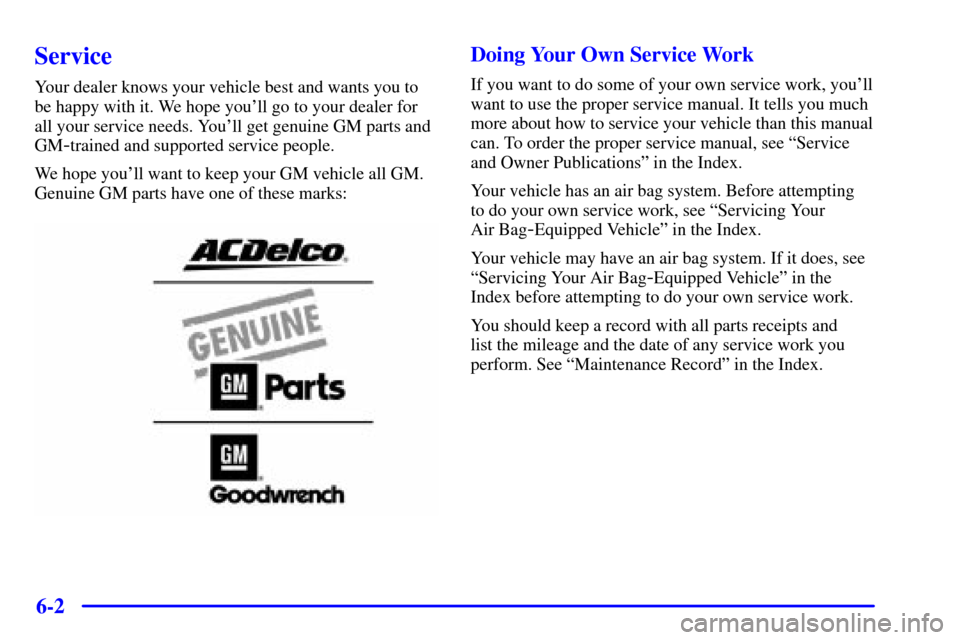
6-2
Service
Your dealer knows your vehicle best and wants you to
be happy with it. We hope you'll go to your dealer for
all your service needs. You'll get genuine GM parts and
GM
-trained and supported service people.
We hope you'll want to keep your GM vehicle all GM.
Genuine GM parts have one of these marks:
Doing Your Own Service Work
If you want to do some of your own service work, you'll
want to use the proper service manual. It tells you much
more about how to service your vehicle than this manual
can. To order the proper service manual, see ªService
and Owner Publicationsº in the Index.
Your vehicle has an air bag system. Before attempting
to do your own service work, see ªServicing Your
Air Bag
-Equipped Vehicleº in the Index.
Your vehicle may have an air bag system. If it does, see
ªServicing Your Air Bag
-Equipped Vehicleº in the
Index before attempting to do your own service work.
You should keep a record with all parts receipts and
list the mileage and the date of any service work you
perform. See ªMaintenance Recordº in the Index.
Page 346 of 468
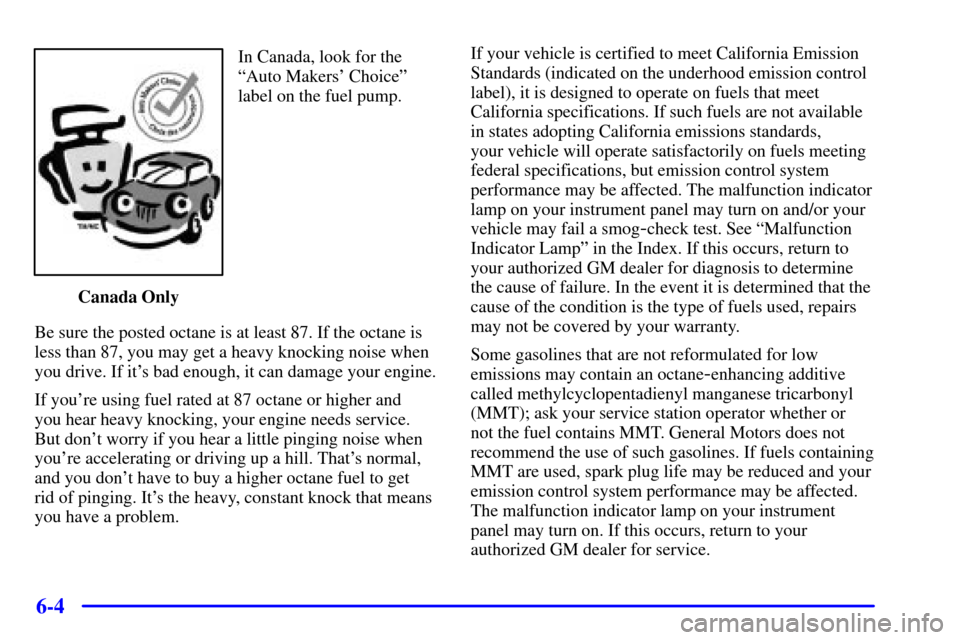
6-4
In Canada, look for the
ªAuto Makers' Choiceº
label on the fuel pump.
Canada Only
Be sure the posted octane is at least 87. If the octane is
less than 87, you may get a heavy knocking noise when
you drive. If it's bad enough, it can damage your engine.
If you're using fuel rated at 87 octane or higher and
you hear heavy knocking, your engine needs service.
But don't worry if you hear a little pinging noise when
you're accelerating or driving up a hill. That's normal,
and you don't have to buy a higher octane fuel to get
rid of pinging. It's the heavy, constant knock that means
you have a problem.If your vehicle is certified to meet California Emission
Standards (indicated on the underhood emission control
label), it is designed to operate on fuels that meet
California specifications. If such fuels are not available
in states adopting California emissions standards,
your vehicle will operate satisfactorily on fuels meeting
federal specifications, but emission control system
performance may be affected. The malfunction indicator
lamp on your instrument panel may turn on and/or your
vehicle may fail a smog
-check test. See ªMalfunction
Indicator Lampº in the Index. If this occurs, return to
your authorized GM dealer for diagnosis to determine
the cause of failure. In the event it is determined that the
cause of the condition is the type of fuels used, repairs
may not be covered by your warranty.
Some gasolines that are not reformulated for low
emissions may contain an octane
-enhancing additive
called methylcyclopentadienyl manganese tricarbonyl
(MMT); ask your service station operator whether or
not the fuel contains MMT. General Motors does not
recommend the use of such gasolines. If fuels containing
MMT are used, spark plug life may be reduced and your
emission control system performance may be affected.
The malfunction indicator lamp on your instrument
panel may turn on. If this occurs, return to your
authorized GM dealer for service.
Page 349 of 468
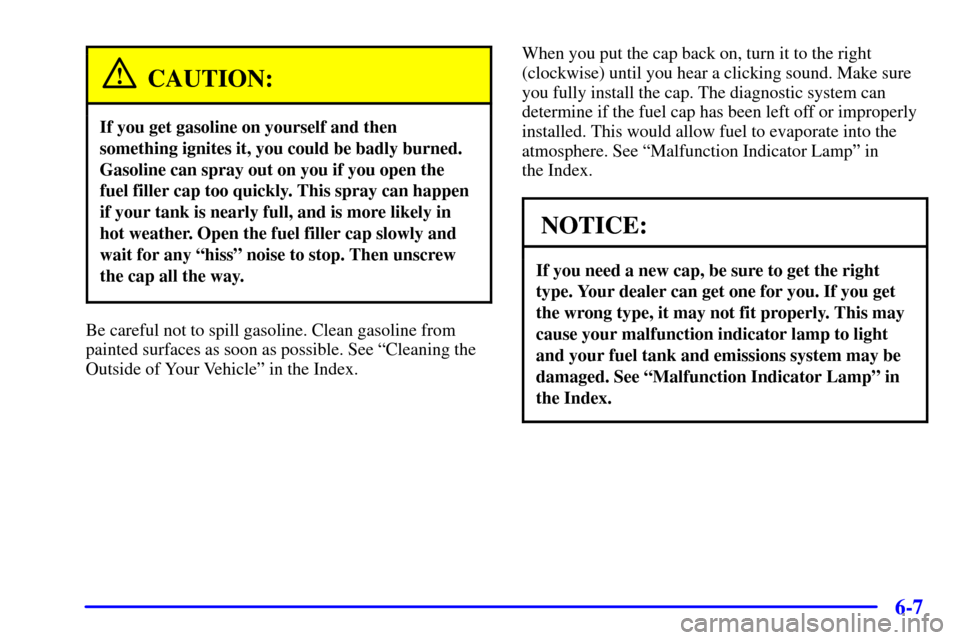
6-7
CAUTION:
If you get gasoline on yourself and then
something ignites it, you could be badly burned.
Gasoline can spray out on you if you open the
fuel filler cap too quickly. This spray can happen
if your tank is nearly full, and is more likely in
hot weather. Open the fuel filler cap slowly and
wait for any ªhissº noise to stop. Then unscrew
the cap all the way.
Be careful not to spill gasoline. Clean gasoline from
painted surfaces as soon as possible. See ªCleaning the
Outside of Your Vehicleº in the Index.When you put the cap back on, turn it to the right
(clockwise) until you hear a clicking sound. Make sure
you fully install the cap. The diagnostic system can
determine if the fuel cap has been left off or improperly
installed. This would allow fuel to evaporate into the
atmosphere. See ªMalfunction Indicator Lampº in
the Index.
NOTICE:
If you need a new cap, be sure to get the right
type. Your dealer can get one for you. If you get
the wrong type, it may not fit properly. This may
cause your malfunction indicator lamp to light
and your fuel tank and emissions system may be
damaged. See ªMalfunction Indicator Lampº in
the Index.
Page 356 of 468
6-14
Engine Oil
If the CHECK ENG OIL
LEVEL light appears on the
instrument panel, it means
you need to check your
engine oil level right away.
For more information, see CHECK ENG OIL LEVEL in
the Index.
You should check your engine oil level regularly; this is
an added reminder.
Checking Engine Oil
It's a good idea to check your engine oil every time you
get fuel. In order to get an accurate reading, the oil must
be warm and the vehicle must be on level ground.
All Other Engines 8100 V8 Engine
The engine oil dipstick has a yellow ring handle and
is located on the passenger's side of the engine.
See ªEngine Compartment Overviewº in the Index
for more information.
Turn off the engine and give the oil several minutes to
drain back into the oil pan. If you don't, the oil dipstick
might not show the actual level.
Pull out the dipstick and clean it with a paper towel or
cloth, then push it back in all the way. Remove it again,
keeping the tip down, and check the level.
Page 357 of 468
6-15
When to Add Engine Oil
If the oil is at or below the then you'll need to add at
least one quart of oil. But you must use the right kind.
This part explains what kind of oil to use. For crankcase
capacity, see ªCapacities and Specificationsº in the Index.
NOTICE:
Don't add too much oil. If your engine has so much
oil that the oil level gets above the cross
-hatched area
that shows the proper operating range, your engine
could be damaged.
All Other Engines 8100 V8 Engine
The engine oil fill cap for the VORTEC 4800, 5300 and
6000 V8 engines is located on the driver's side engine
valve cover. On the 8100 engine, the oil fill cap is
located on the driver's side engine valve cover. See
ªEngine Compartment Overviewº in the Index for
more information on location.
Be sure to fill it enough to put the level somewhere in
the proper operating range. Push the dipstick all the way
back in when you're through.
Page 360 of 468
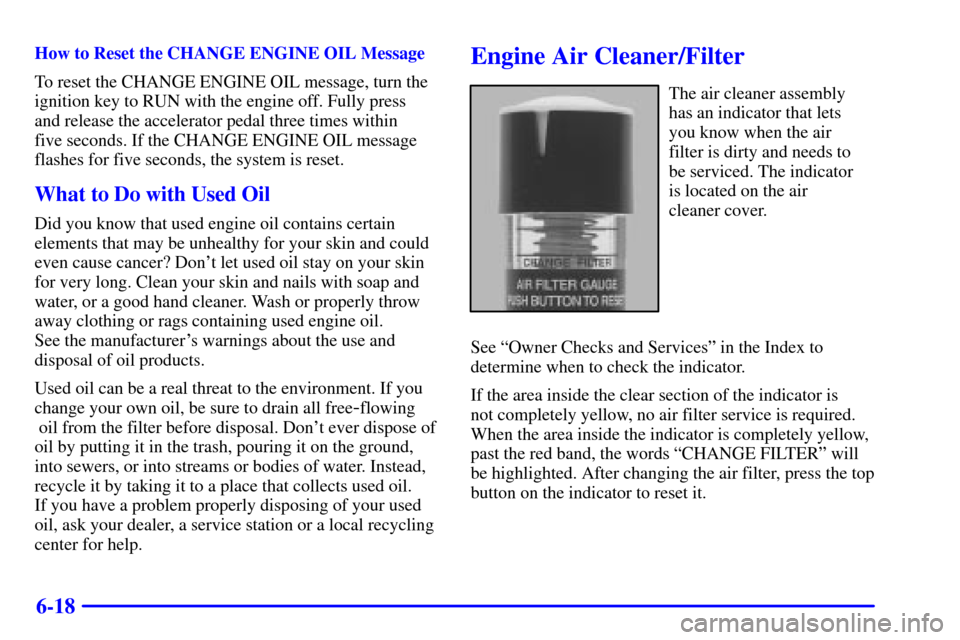
6-18
How to Reset the CHANGE ENGINE OIL Message
To reset the CHANGE ENGINE OIL message, turn the
ignition key to RUN with the engine off. Fully press
and release the accelerator pedal three times within
five seconds. If the CHANGE ENGINE OIL message
flashes for five seconds, the system is reset.
What to Do with Used Oil
Did you know that used engine oil contains certain
elements that may be unhealthy for your skin and could
even cause cancer? Don't let used oil stay on your skin
for very long. Clean your skin and nails with soap and
water, or a good hand cleaner. Wash or properly throw
away clothing or rags containing used engine oil.
See the manufacturer's warnings about the use and
disposal of oil products.
Used oil can be a real threat to the environment. If you
change your own oil, be sure to drain all free
-flowing
oil from the filter before disposal. Don't ever dispose of
oil by putting it in the trash, pouring it on the ground,
into sewers, or into streams or bodies of water. Instead,
recycle it by taking it to a place that collects used oil.
If you have a problem properly disposing of your used
oil, ask your dealer, a service station or a local recycling
center for help.
Engine Air Cleaner/Filter
The air cleaner assembly
has an indicator that lets
you know when the air
filter is dirty and needs to
be serviced. The indicator
is located on the air
cleaner cover.
See ªOwner Checks and Servicesº in the Index to
determine when to check the indicator.
If the area inside the clear section of the indicator is
not completely yellow, no air filter service is required.
When the area inside the indicator is completely yellow,
past the red band, the words ªCHANGE FILTERº will
be highlighted. After changing the air filter, press the top
button on the indicator to reset it.
Page 361 of 468
6-19
Your air cleaner is located in the passenger's side front
corner of the engine compartment. See ªEngine
Compartment Overviewº in the Index for more
information on location.1. To remove the air filter, loosen the screws on the
cover. Lift the cover upward. Lift the filter from the
air cleaner housing. Care should be taken to dislodge
as little dirt as possible.
2. Clean the filter sealing surface and the filter housing.
3. Install the new filter.
4. Install the cover and tighten the screws on the air
cleaner cover.
Refer to the Maintenance Schedule to determine when to
replace the air filter. See ªOwner Checks and Servicesº
in the Index.